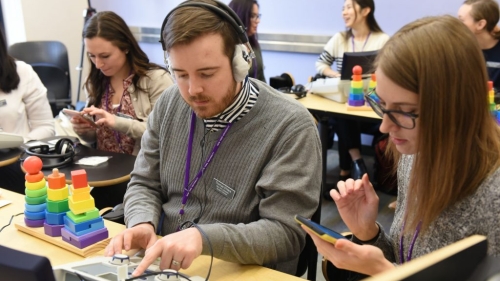Stacey Rimikis, clinical assistant professor in Steinhardt’s Department of Communicative Sciences and Disorders, is a practicing speech-language pathologist who specializes in communication and swallowing impairment in adult and geriatric populations. Her research investigates the underlying mechanisms of language processing and production in both impaired and unimpaired populations in order to guide the development of clinical intervention. We spoke to her about her research and practice.

You research language processing and production. How does your research guide your clinical practice?
Researching the underlying mechanisms of language has helped me to dig deeper with my clients and really examine not just the communication challenges that they’re experiencing, but the underlying reasons why their issues present in a particular way. This focus has improved my ability to provide individualized, person-centered therapy. This is something I try to pass on to my students as well, ensuring that they fully understand the theoretical and empirical underpinnings of impairment and intervention, so that they can connect these concepts to their work as emerging clinicians.
Researching the underlying mechanisms of language has helped me to dig deeper with my clients and really examine the underlying reasons why their issues present in a particular way.
You also study aphasia. Is there anything new in the treatment of people with this disorder?
One development I’m particularly excited about is the potential use of non-invasive neuromodulation, like transcranial direct current stimulation (tDCS), in rehabilitation therapy. This type of stimulation applies a low-level electrical current to the scalp, modulating brain activity, and potentially improving treatment outcomes. I’ve had the opportunity to be involved in work investigating the use of tDCS with individuals with stroke-based speech impairments, and there seems to be strong potential for using this technology to enhance the effects of behavioral speech therapy for this population. Although work investigating the application of tDCS to aphasia treatment is still in its early stages, I’m very excited to see where it goes in the future.
How has the pandemic influenced your practice?
I have been able to continue working clinically throughout the pandemic in nursing and rehabilitation settings, but the biggest shift has been transitioning to remote therapy for my in-home clients. Communicating through a computer screen and losing the nuances of direct face-to-face interaction can be particularly difficult for someone with a communication impairment. However, it has also provided opportunities for creative problem solving on both sides, and highlighted my clients’ perseverance and dedication to improving their communication skills even in the face of these challenges.
Related Department

Communicative Sciences and Disorders
665 Broadway, 9th floor
New York, NY 10012
Phone: 212-998-5230
